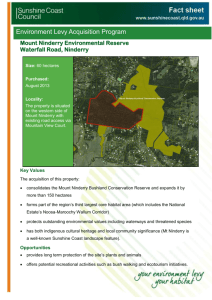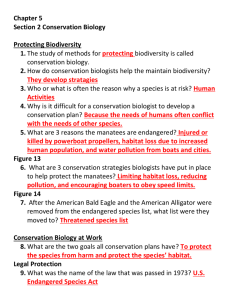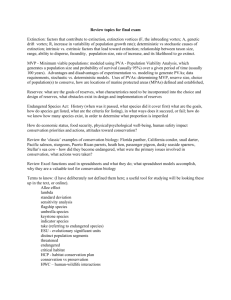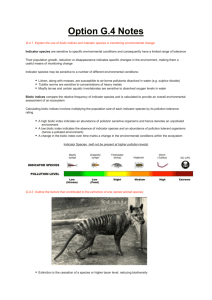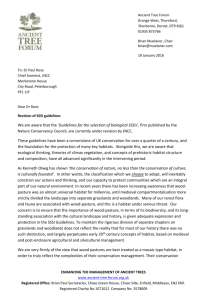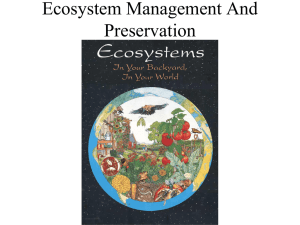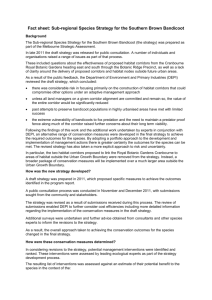Designing Conservation Areas
advertisement
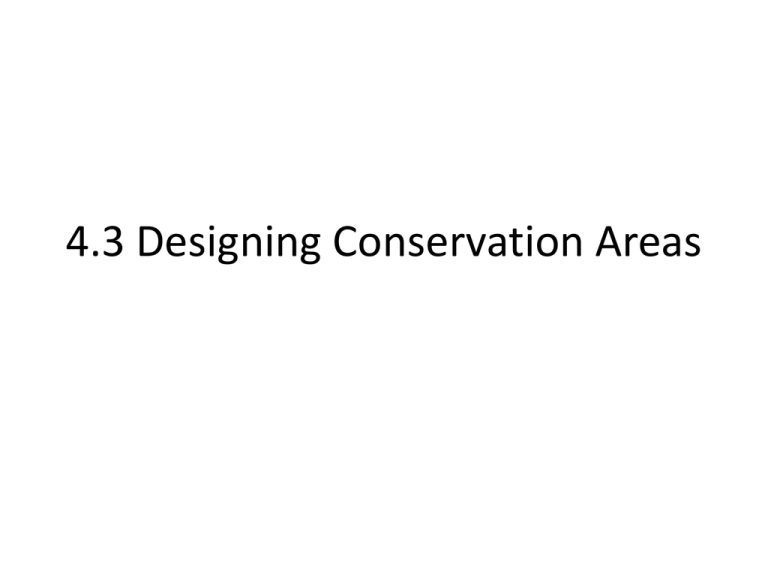
4.3 Designing Conservation Areas What do we need to consider? • The design of protected areas is an important field of research in conservation biology. The essential questions involve criteria for the size, shape, and positioning of protected areas to optimize their ability to protect biodiversity, while using funding as efficiently as possible. Conservation biologists recommend that protected areas be as large and numerous as possible. Other design aspects, however, are more controversial. Controversy over the design of protected areas involves the following key elements: S.L.O.S.S Is it preferable to have one large reserve, or a number of smaller ones of the same total area? Conservation biologists identify this question with the acronym SLOSS, which stands for: single large, or several small. According to ecological theory, populations in larger protected areas should have a smaller risk of extinction, compared to those in smaller reserves. However, if there are populations in several different reserves, the redundancy might prevent extinction in the event of a catastrophic loss in one reserve. Total number of species of amphibians and reptilians on seven different islands in the West Indies. Based on Figure 2 on page 8 of "The theory of island biogeography" by MacArthur and Wilson, itself based on research by Darlington circa 1957. (Hence, the numbers are likely to differ from actual numbers today Edge effects Reserves can also be designed to have less edge (or ecotone) habitat. This refers to transitions between ecosystem types, such as that between a forest and a field. Edge habitat is often penetrated by invasive species and predators, which can become important problems in some protected areas. In addition, many species require interior habitat for breeding; meaning they are intolerant of ecotones. Larger protected areas have proportionately more interior habitat, as do simple-shaped ones (a circle has the smallest ratio of edge to area). Connectivity For many ecological functions to operate well, there must be connections among habitats. This is particularly true of the dispersal of plants and animals. This need can be accommodated if protected areas are linked by corridors of suitable habitat, or if they are clumped close together. However, corridors might also serve as conduits for invasive species and diseases. Once You’ve set up a protected area… The conservation of biodiversity in protected areas also requires the monitoring of key ecological values, such as the populations of endangered species and the health of natural ecosystems. It may also be necessary to conduct research to determine the appropriate kinds of management required, and to then implement that management. Management includes actions such as patrolling to prevent poaching of timber and animals, altering habitats to maintain their suitability for threatened species, and captive breeding and release of endangered species. Read more: Protected Area - Design Of Protected Areas Habitat, Species, Edge, Reserves, Conservation, and Biologists http://science.jrank.org/pages/5532/ProtectedArea-Design-protected-areas.html#ixzz1XEpvzR00 Protected Area - Management Of Protected Areas Species and Endangered http://science.jrank.org/pages/5533/ProtectedArea-Management-protectedareas.html#ixzz1XEs4zBz8 Mkomazi a habitat and species conservation success ? Read the article on Mkomazi game reserve in Tanzania http://en.wikipedia.org/wiki/Mkomazi_Game_Reserve How did the reserve come into being? Which is it; S.L.O.S.S? What other reserves does it link to? What was the initial impact on local residents? What does Tony Fitzjohn do for the displaced peoples? Where and how does he get his funding? What 2 critically endangered species are being targeted? How is each being conserved? What do critics claim is Mkomazi is becoming a ‘benchmark’ for? Do you think it is a fair judgement? Look at the following site for an alternative perspective using an example in Ethiopia. http://www.conservationrefugees.org/ You could use the following images to illustrate your answers: Black Rhino: http://en.wikipedia.org/wiki/File:Black_Rhinos_Kenya.jpg African Wild Dog: http://en.wikipedia.org/wiki/File:Lycaon_pictus_(Temminck,_1820).jpg The map (you can resize it) taken from: http://www.rgs.org/NR/rdonlyres/8E81543E-AAFB42F5-A694-8218E7D4AB62/0/Mkomazi.pdf Local Masai: http://lh5.ggpht.com/_OLjkq7vEFfQ/TC33LoQRcoI/AAAAAAAAHAk/qROJoWny6I/DSCN2133.JPG And http://cdnstatic-2.mydestination.com/tanzania/Pictures/HomePageGallery/20110508160312.Full.jpg Managing the ecosystem to ensure survival Citations http://science.jrank.org/pages/5532/ProtectedArea-Design-protected-areas.html Protected Area - Design Of Protected Areas http://en.wikipedia.org/wiki/File:The_Theory_ of_Island_Biogeography.gif

